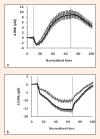Localised muscle tissue oxygenation during dynamic exercise with whole body vibration
- PMID: 24149209
- PMCID: PMC3737862
Localised muscle tissue oxygenation during dynamic exercise with whole body vibration
Abstract
Despite increasing use of whole body vibration during exercise an understanding of the exact role of vibration and the supporting physiological mechanisms is still limited. An important aspect of exercise analysis is the utilisation of oxygen, however, there have been limited studies considering tissue oxygenation parameters, particularly during dynamic whole body vibration (WBV) exercise. The aim of this study was to determine the effect of adding WBV during heel raise exercises and assessing changes in tissue oxygenation parameters of the lateral gastrocnemius using Near Infra Red Spectroscopy (NIRS). Twenty healthy subjects completed ten alternating sets of 15 heel raises (vibration vs. no vibration). Synchronous oxygenation and motion data were captured prior to exercise to determine baseline levels, for the duration of the exercise and 20 sec post exercise for the recovery period. Both vibration and no vibration conditions elicited a characteristic increase in deoxyhaemoglobin and decreases in oxyhaemoglobin, total haemoglobin, tissue oxygenation index and normalised tissue haemoglobin index which are indicative of local tissue hypoxia. However, the addition of vibration elicited significantly lower (p < 0. 001) depletions in oxyhaemoglobin, total haemoglobin, normalised tissue haemoglobin index but no significant differences in deoxyhaemoglobin. These findings suggest that addition of vibration to exercise does not increase the cost of the exercise for the lateral gastrocnemius muscle, but does decrease the reduction in local muscle oxygenation parameters, potentially resulting from increased blood flow to the calf or a vasospastic response in the feet. However, further studies are needed to establish the mechanisms underlying these findings. Key pointsWhole body vibration affects tissue oxygenation of the lateral gastrocnemius.The underlying mechanism could be either increased blood flow or a vasospastic response in the feet.The local metabolic cost of heel raise activity on the lateral gastrocnemius does not appear to be increased by whole body vibration.
Keywords: Heel raise; NIRS; Vibration; gastrocnemius; oxygenation.
Figures




Similar articles
-
The influence of whole body vibration on the plantarflexors during heel raise exercise.J Electromyogr Kinesiol. 2013 Jun;23(3):614-8. doi: 10.1016/j.jelekin.2012.11.015. Epub 2012 Dec 21. J Electromyogr Kinesiol. 2013. PMID: 23261083
-
Muscle tissue oxygenation and VEGF in VO-matched vibration and squatting exercise.Clin Physiol Funct Imaging. 2010 Jul;30(4):269-78. doi: 10.1111/j.1475-097X.2010.00937.x. Epub 2010 May 23. Clin Physiol Funct Imaging. 2010. PMID: 20497445
-
Vastus lateralis oxygenation and blood volume measured by near-infrared spectroscopy during whole body vibration.Clin Physiol Funct Imaging. 2005 Jul;25(4):203-8. doi: 10.1111/j.1475-097X.2005.00614.x. Clin Physiol Funct Imaging. 2005. PMID: 15972021 Clinical Trial.
-
A brief review of the use of near infrared spectroscopy with particular interest in resistance exercise.Sports Med. 2007;37(7):615-24. doi: 10.2165/00007256-200737070-00005. Sports Med. 2007. PMID: 17595156 Review.
-
Evaluation of intra-musclar oxygenation during exercise in humans.J Sports Sci Med. 2002 Mar 20;1(1):15-9. eCollection 2002 Mar. J Sports Sci Med. 2002. PMID: 24672267 Free PMC article. Review.
Cited by
-
Use of cortical hemodynamic responses in digital therapeutics for upper limb rehabilitation in patients with stroke.J Neuroeng Rehabil. 2024 Jul 10;21(1):115. doi: 10.1186/s12984-024-01404-y. J Neuroeng Rehabil. 2024. PMID: 38987817 Free PMC article.
-
Relationship between lower limb muscle activity and cortical activation among elderly people during walking: Effects of fast speed and cognitive dual task.Front Aging Neurosci. 2023 Jan 10;14:1059563. doi: 10.3389/fnagi.2022.1059563. eCollection 2022. Front Aging Neurosci. 2023. PMID: 36704503 Free PMC article.
-
Effects of whole-body vibration or resistive-vibration exercise on blood clotting and related biomarkers: a systematic review.NPJ Microgravity. 2023 Dec 6;9(1):87. doi: 10.1038/s41526-023-00338-4. NPJ Microgravity. 2023. PMID: 38057333 Free PMC article. Review.
-
Modulating Effects of Whole-body Vibration on Cortical Activity and Gait Function in Chronic Stroke Patients.Brain Neurorehabil. 2020 Mar 26;13(2):e12. doi: 10.12786/bn.2020.13.e12. eCollection 2020 Jul. Brain Neurorehabil. 2020. PMID: 36744184 Free PMC article.
-
Changes in Cortical Activity during Preferred and Fast Speed Walking under Single- and Dual-Tasks in the Young-Old and Old-Old Elderly.Brain Sci. 2021 Nov 23;11(12):1551. doi: 10.3390/brainsci11121551. Brain Sci. 2021. PMID: 34942853 Free PMC article.
References
-
- Baechle T.R., Earle R.W.(2008) Essentials of strength training and conditioning. Human Kinetics.
-
- Boushel R., Langberh H., Olesen J., Gonzales-Alonzo J., Burlow J., Kjaer (2001)Monitoring tissue oxygenation availability with near infrared spectroscopy (NIRS) in health and disease. Scandinavian Journal of Medicine and Science in Sports 11, 213-222 - PubMed
-
- Bhambhani Y., Tuchak C., Burnham R., Jeon J., Maikala R.(2000)Quadriceps muscle deoxygenation during functional electrical stimulation in adults with spinal cord injury. Spinal Cord 38, 630-638 - PubMed
-
- Button C, Anderson N, Bradford C, Cotter J.D., Ainslie P.N.(2007)The effect of multidirectional mechanical vibration on peripheral circulation of humans. Clinical Physiology and Functional Imaging 27, 211-216 - PubMed
-
- Cardinale M., Ferrari M., Quaresima V.(2007)Gastrocnemius medialis and vastus lateralis oxygenation during whole-body vibration exercise. Medicine and Science in Sports and Exercercise 39(4), 694-700 - PubMed
LinkOut - more resources
Full Text Sources
